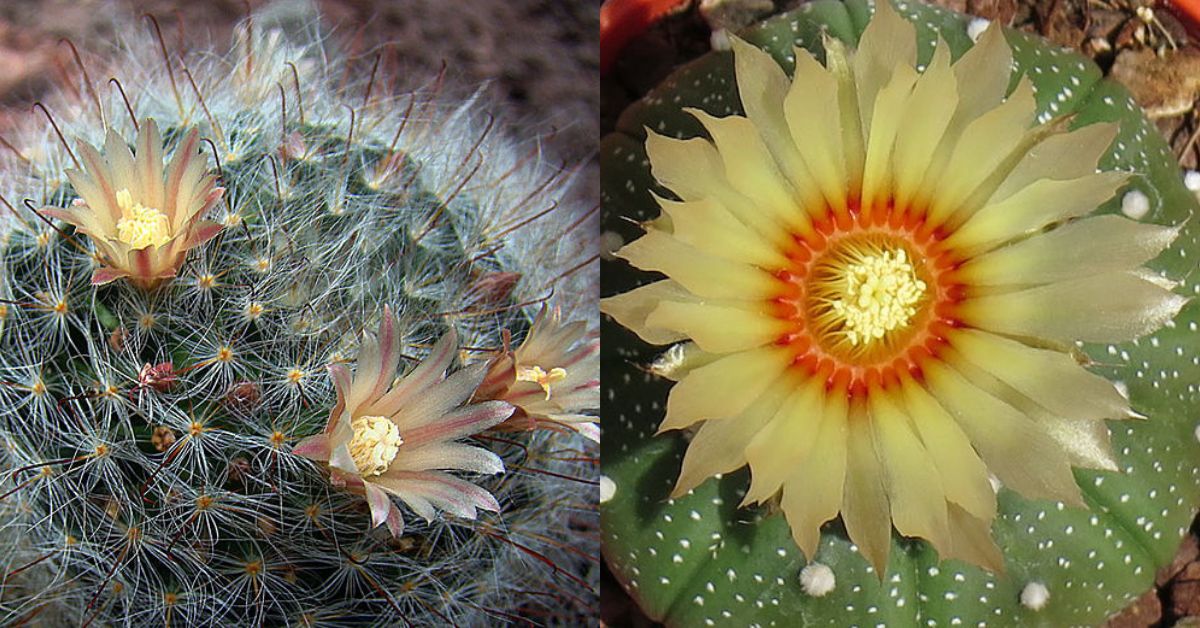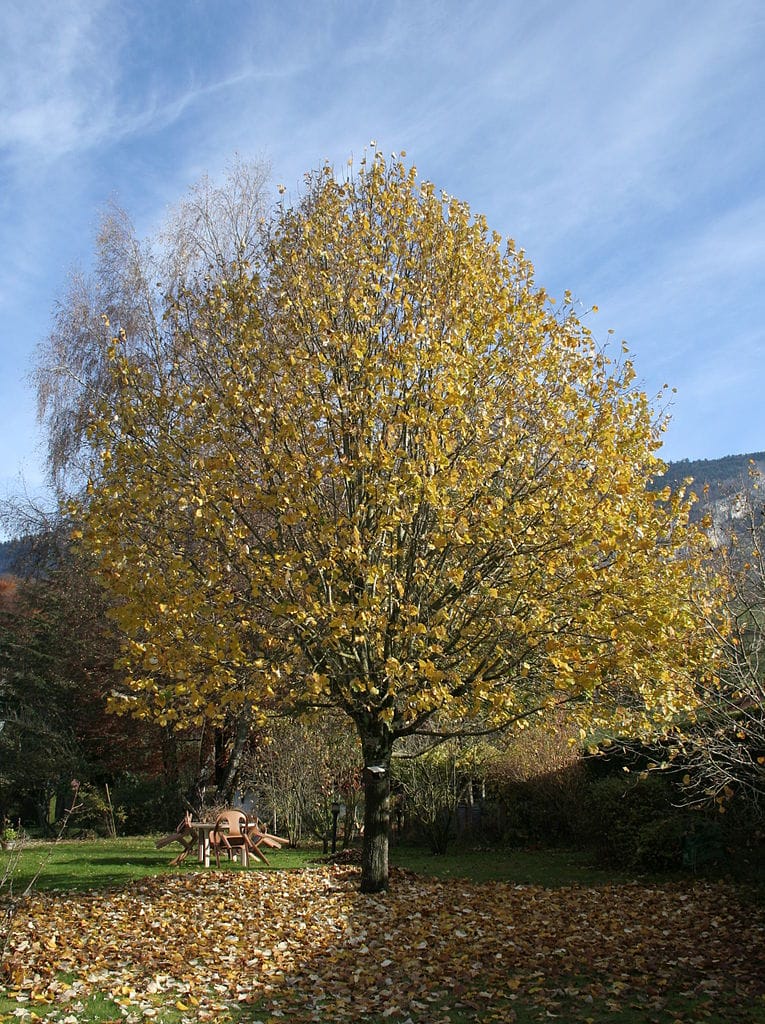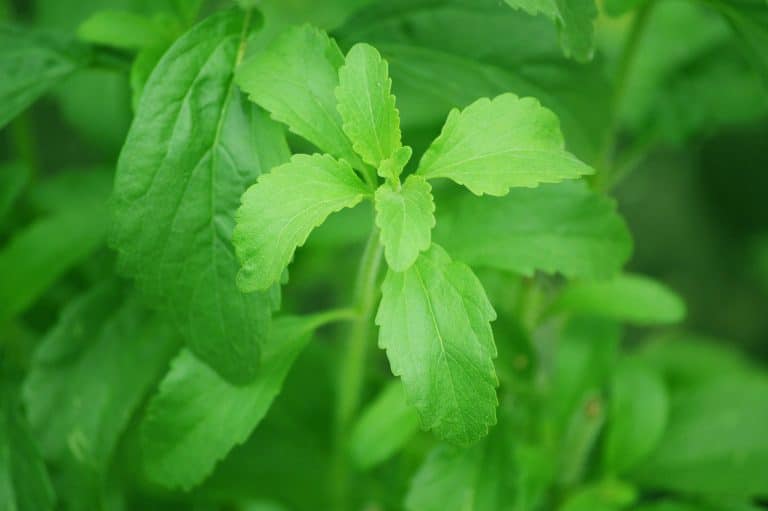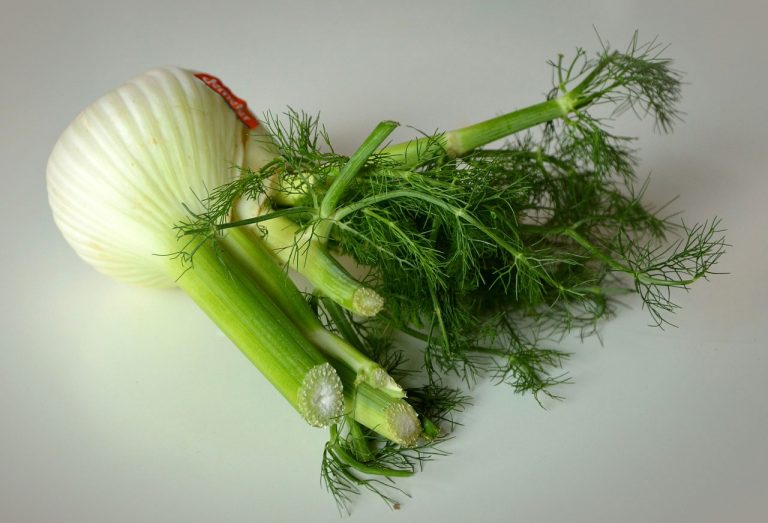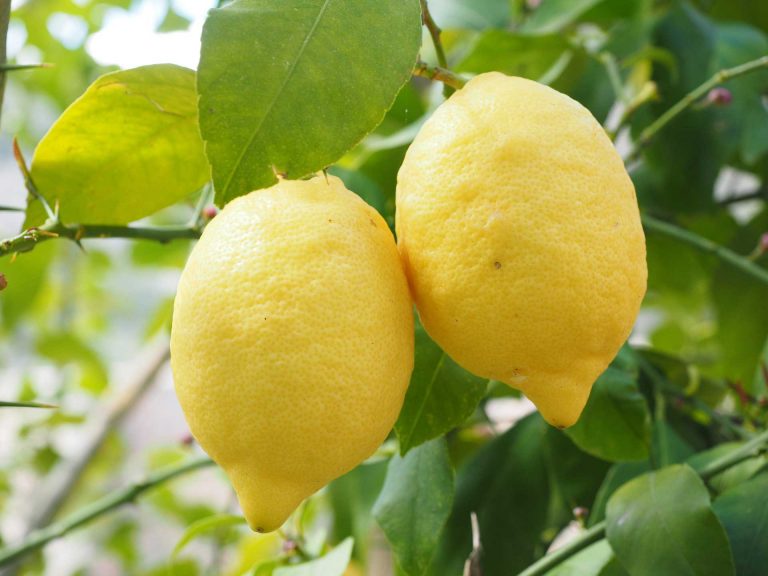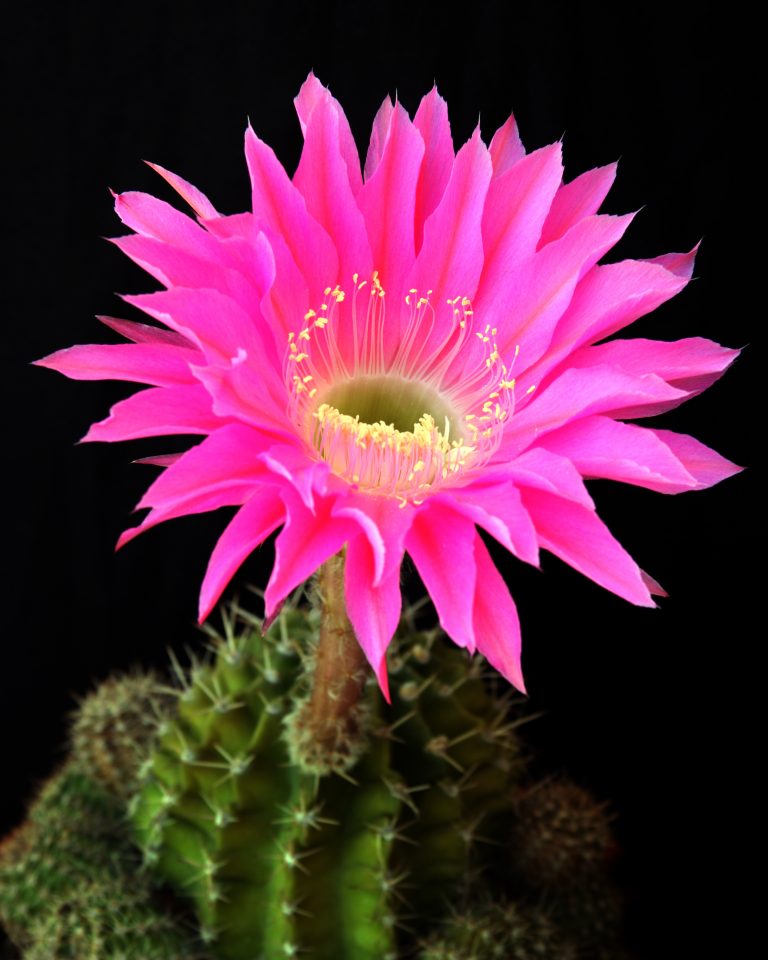Cactus Flowers: Species & Tips for Encouraging Blooming
Cacti have a special place in the hearts of plant lovers. It’s true that some people consider it a bit of a boring plant, but one look at it during the blooming period is enough to change your mind and make you think that cacti have one of the most amazing flowers. What color, size, and shape of flower should you wish for so that the cactus doesn’t have it?
Such a variety of cactus flowers could explain why this flower has inspired nature-loving artists like O’Keeffe, who created masterpieces featuring cactus flowers. But the beauty of these flowers isn’t everything. Some people adore these flowers because of their short lives and unusual personalities. In fact, some cactus flowers bloom only at night and live for only a couple of hours.
Let’s learn more about cactus flowers to help you promote their blooming and enjoy the most appealing flowers.
What Makes Cactus Flowers Unique?
It’s hard not to agree with the conventional wisdom that suggests that flowers have their own needs based on their characteristics. At this point, you might be interested in knowing what makes cactus flowers stand out from all the other flowers. One of the most outstanding features is indeed its range of colors, which includes shades of red, pink, orange, yellow, white, etc.
Take a look and you’ll immediately notice that cactus flowers are noticeably larger than their branches. However, this size difference is perfectly proportionate and adds to the distinctiveness of cactus flowers. It’s unfortunate, though, that most cactus flowers only bloom for a short time. Yet we can all agree that this brevity contributes more to the experience of witnessing the blossoming of cactus flowers.
When discussing cactus flowers, it’s important to mention their purpose. Cacti have evolved night-blooming flowers as a strategy to attract creatures like bats for pollination. This ingenious approach significantly increases the chances of reproduction.
Popular Flowering Cactus
We have carefully compiled a list of some of the most popular cacti that you can use to adorn your home and office. Considering that the maintenance of cacti is very comfortable, these 5 blooming cacti presented below will undoubtedly be a great addition to your personal space.
1. Easter Lily Cactus
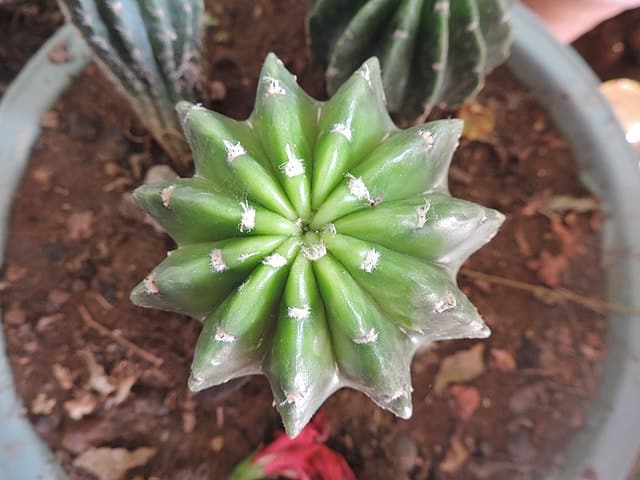
The Easter Lily Cactus flowers have a trumpet shape and come in white, pink, red, and orange colors. This species of cactus can take up to 4 years to produce flowers, but the results are so impressive that it’s worth every minute of the wait. The homeland of the Easter Lily Cactus is Mexico and South America. However, there are many hybrids of this plant spread around the world, whose flowers have an amazing fragrance along with the beauty characteristic of the species.
As you might have guessed from the name, the Easter Lily Cactus flowers bloom in the spring, during the Easter holiday. The species is drought tolerant and requires only minimal watering, even during the hot summer season. At best, we recommend planting them in well-drained soil in full sun or partial shade.
2. Christmas Cactus
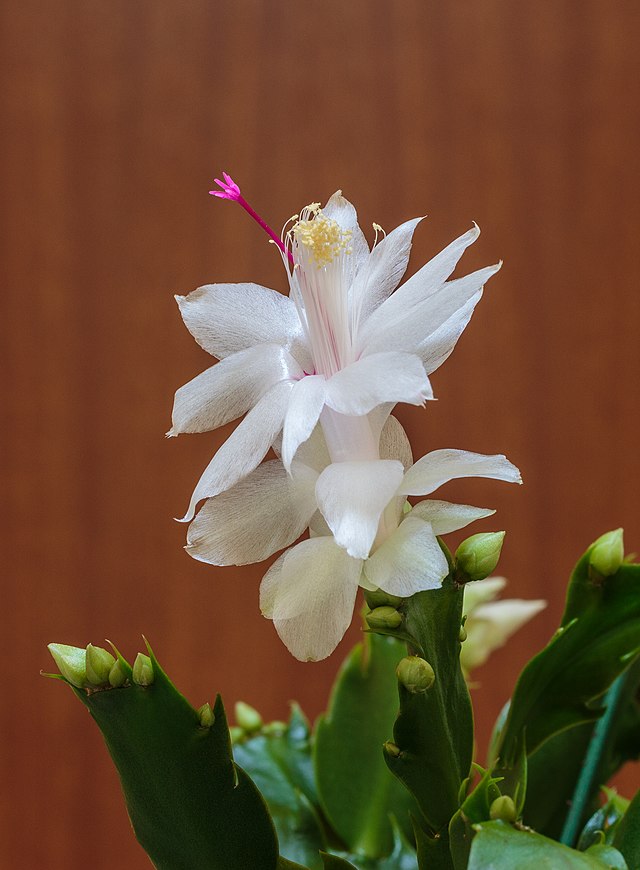
Eastern and Christmas cactus names are clear examples of how we often like to name specific objects and things after occasions that are dear to us. As the name suggests, these types of cactus flowers bloom during Christmas, but strangely enough, the Christmas cactus is native to the South American rainforest instead of the desert.
Unlike the Easter Lily Cactus flower’s characteristic trumpet shape, the Christmas cactus is known for its tubular 20-30 petals flowers, which are usually found in red, pink, white, or orange. For this particular species of flower, we advise keeping it in a bright room. Still, keep in mind that it likes indirect lighting. As for the soil, it should have good drainage and should only be watered when the top few inches of soil are dry.
3. Strawberry Hedgehog Cactus
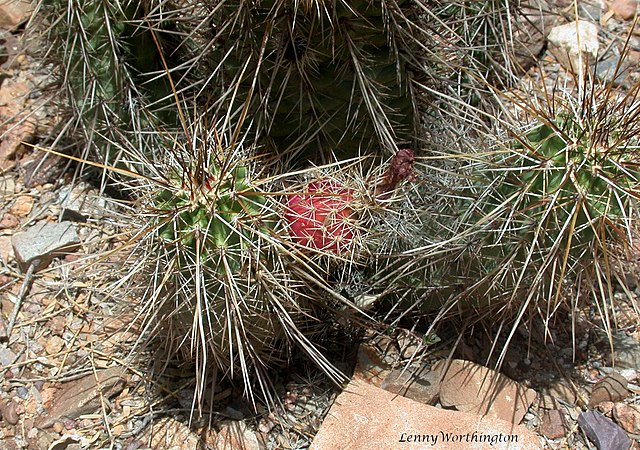
Who doesn’t love Pitaya? You might think that this delicious fruit has nothing to do with cactus, but the reason why Strawberry Hedgehog Cactus gained worldwide prevalence is the fact that it produces an aromatic strawberry-like fruit that ripens in July and is often referred to as pitaya. Because of this exotic fruit, the Strawberry Hedgehog Cactus was especially beloved by desert inhabitants. Even nowadays, the majority of people agree that the Strawberry Hedgehog Cactus is the most beautiful desert-blooming plant.
Strawberry Hedgehog Cactus stems have cylindrical shapes and are covered with long needles that require careful handling. As long as you don’t deprive them of enough light and proper care, this type of cactus will reward you with beautiful flowers every spring.
4. Star Cactus
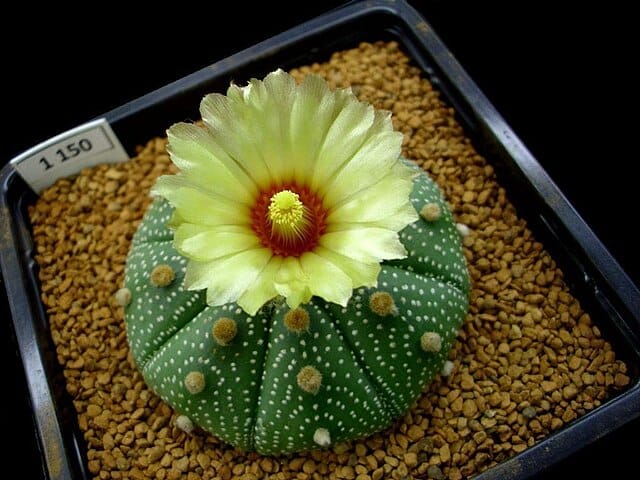
Owners of Star Cactus might find this fact unfortunate but as a matter of fact, the Star Cactus doesn’t start flowering until it’s about 2 years old. Therefore, you have to wait a couple of years to discover firsthand how the Star Cactus is blooming with its yellow and orange flowers. Star Cactus is native to the deserts of the southwestern United States and northern Mexico and measures around 3 inches in height. This compact size is exactly what helps it fit comfortably in even the smallest of spaces.
5. Powder Puff Cactus
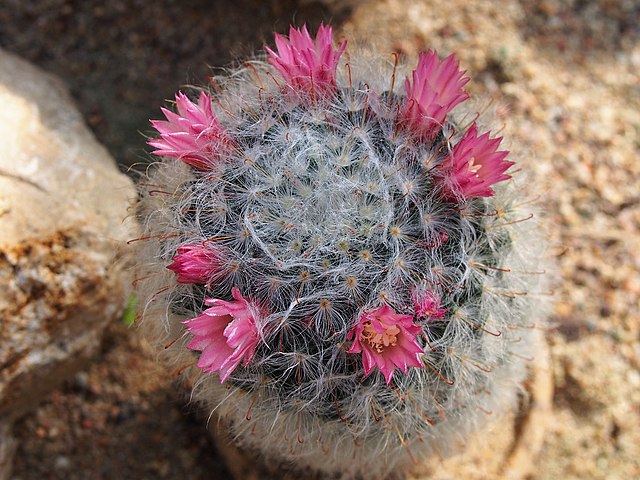
This round cactus is native to the high altitudes of central Mexico and is covered in countless tiny bracts. The best part about this species is that it produces incredibly beautiful, tiny pink cactus flowers. If you’re lucky, your Powder Puff Cactus might even produce enough flowers to cover the body in flowers. Keep in mind that the Powder Puff Cactus blooms for about 2 weeks and offers creamy-white or sometimes pink flowers.
Due to the drastic decrease in the number of this cactus, today in Mexico, people are forbidden to collect Powder Puff Cactus from the wild (however, you can still buy a hybrid species and enjoy its flowers).
4 Tips to Encourage Cactus Flowering
1. Manage Watering Intensity
Reduced water supplies and drought-like conditions can cause certain species of cacti to fail to bloom. The reason for this is that in their native environment, which is sometimes incredibly dry, cacti are habitually water-deprived, and flowering at such times allows them to reproduce before harsh conditions occur. Like other succulents, cacti don’t like too much water, so we recommend choosing a medium-sized pot with great drainage.
From spring to autumn, water the cactus only when the soil is completely dry. With the onset of cold weather, be sure to reduce the intensity of watering.
2. Get Enough Light
Just like our organisms require light to thrive, one of the requirements that will help cacti produce flowers is a sufficient amount of light. Considering this, it’s natural that the flowering of some cacti depends on how much light they receive. Typically, cacti bloom when they receive at least 10 hours of direct light during the day.
To get the ideal conditions, you should place the cactus near the south or west window of the building. But if your plant still can’t get enough light naturally, then you may have to use artificial light sources.
3. Fluctuate Temperature
Anyone who has at least some experience interacting with flowers understands that some plants require a change between cool nighttime and warm daytime temperatures to stimulate flowering. Cacti is among those plants – it requires fluctuating temperatures Therefore, you should try to replicate natural temperature swings. For this, you should cool nighttime temperatures to around 50-55°F and increase daytime temperatures to around 70-85°F. Don’t forget to avoid placing cacti near heaters or air conditioners as well – extreme temperature changes may delay the flowering process.
4. Choose a Well-Draining Soil
As we already mentioned, cacti are desert plants, which means that they are accustomed to living in sandy and well-drained soils. That’s exactly why it’s important that the soil that you prepare for the cactus resembles its native soil as much as possible.
To accomplish this, the best way is to use soil whose composition is specially designed for cacti and succulents. After selecting the soil, it’s necessary to pay special attention to the type of pot and choose one that features large drainage holes.
Final Thoughts
All in all, blooming cacti and making their flowers come to life isn’t complicated at all. Still, knowing these specific details that we’ve discussed will indeed speed up the process. As a final note, Saguaro, Agave Americana, and Agave Ocahui aren’t types of cactus that bloom easily and often. On the contrary, these three types of cacti take decades to mature and flower. For instance, Agave Americana and Agave Ocahui take 20 to 30 years to flower, but the wait will be worth every minute. Agave spends so much energy on flower production that it usually dies after the flowers are formed.
As for the Saguaro, this type of cactus takes 30 to 50 years to flower, and this process lasts only for 1 day. This truly rare sight delights visitors with large and sophisticated white and yellow flowers. Like other types of cacti, saguaro flowers turn into red fruits and open when ripe, so they are often compared to red flowers.

Nato is a content writer and researcher with a background in psychology who’s eager to explore the wonders of nature. As a travel enthusiast and animal lover, she hopes to inspire others to discover and cherish the beauty and importance of the natural world.

